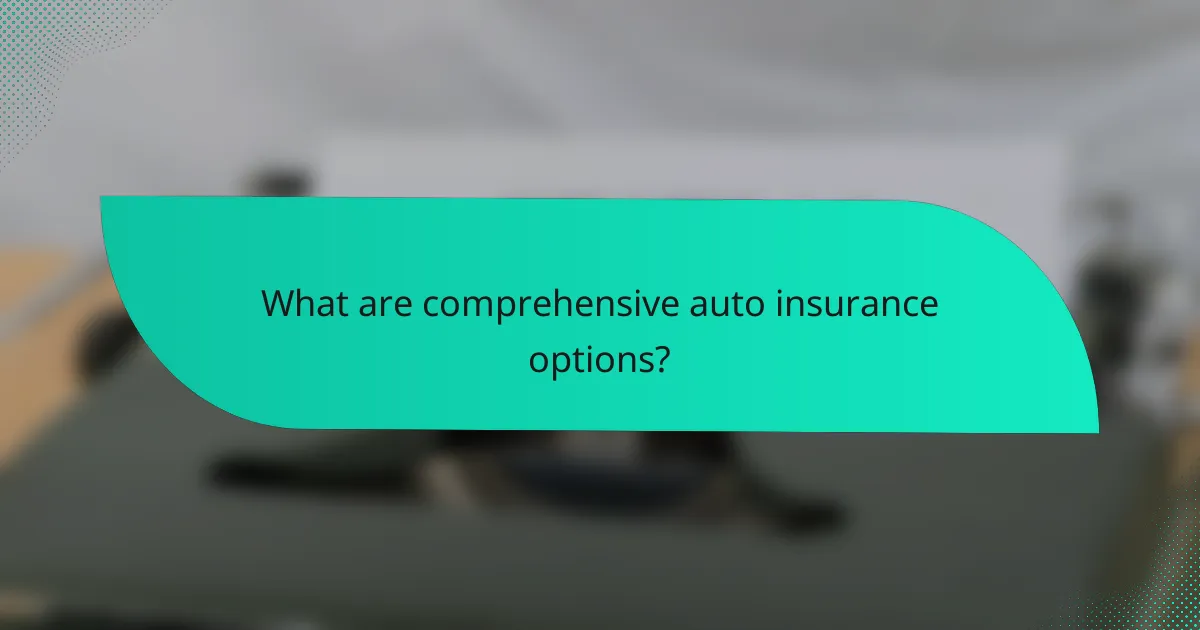Auto insurance policies are essential for protecting drivers from various risks on the road, typically encompassing liability coverage, collision protection, and comprehensive options. Liability coverage safeguards you financially if you’re at fault in an accident, while collision protection ensures your vehicle is repaired after a collision, regardless of fault. Comprehensive options further enhance your coverage by addressing non-collision-related incidents, providing a well-rounded safety net for all drivers.

What are the best auto insurance policies in the United States?
The best auto insurance policies in the United States typically include a mix of liability coverage, collision protection, and comprehensive options. These policies cater to various needs and budgets, ensuring drivers are adequately protected against potential risks on the road.
Liability coverage options
Liability coverage is essential for any auto insurance policy, as it protects you from financial loss if you are at fault in an accident. This coverage generally includes bodily injury liability, which pays for injuries to others, and property damage liability, which covers damage to another person’s property.
In the U.S., minimum liability coverage requirements vary by state, often ranging from $25,000 to $50,000 for bodily injury per person and $10,000 to $25,000 for property damage. It’s advisable to consider higher limits to ensure adequate protection against potential lawsuits.
Collision protection plans
Collision protection plans cover damage to your vehicle resulting from a collision with another vehicle or object, regardless of fault. This type of coverage is particularly important for newer or more valuable cars, as repair costs can be significant.
When selecting a collision plan, consider your deductible—the amount you pay out-of-pocket before insurance kicks in. Common deductibles range from $250 to $1,000. A higher deductible can lower your premium, but it also means more out-of-pocket expenses in the event of an accident.
Comprehensive insurance features
Comprehensive insurance covers damages to your vehicle not involving a collision, such as theft, vandalism, or natural disasters. This coverage is crucial for protecting your investment against unforeseen events that could lead to significant financial loss.
Many policies include a deductible for comprehensive claims as well. It’s wise to evaluate the value of your vehicle and the risks in your area to determine if comprehensive coverage is necessary. In some cases, lenders may require it if you have a car loan.
Top providers in the US
Some of the top auto insurance providers in the U.S. include State Farm, Geico, Progressive, and Allstate. These companies are known for their comprehensive coverage options, competitive pricing, and strong customer service.
When choosing a provider, consider factors such as customer reviews, claim handling efficiency, and available discounts. It’s beneficial to obtain quotes from multiple insurers to compare coverage options and find the best fit for your needs and budget.

How does liability coverage work?
Liability coverage protects you financially if you’re responsible for causing damage or injury to others in an accident. It typically covers costs related to property damage and medical expenses, ensuring that you can meet legal obligations without significant financial strain.
Definition of liability coverage
Liability coverage is a fundamental component of auto insurance that pays for damages you cause to another person’s vehicle or property, as well as medical expenses for injuries sustained by others in an accident where you are at fault. This type of coverage does not pay for your own injuries or vehicle damage; it strictly covers third-party claims.
There are two main types of liability coverage: bodily injury liability, which covers medical costs for injuries to others, and property damage liability, which covers damage to someone else’s property. Understanding these distinctions is crucial for selecting the right policy for your needs.
State minimum requirements
Each state in the U.S. has its own minimum requirements for liability coverage, which can vary significantly. For example, some states may require a minimum of $25,000 for bodily injury per person and $50,000 per accident, along with $10,000 for property damage. It’s essential to check your state’s specific requirements to ensure compliance.
While meeting state minimums is necessary, it may not provide adequate protection in the event of a serious accident. Consider purchasing higher limits to safeguard your assets effectively. Additionally, some states may offer uninsured/underinsured motorist coverage, which can be beneficial if you’re in an accident with a driver who lacks sufficient insurance.

What does collision protection cover?
Collision protection covers damage to your vehicle resulting from a collision with another vehicle or object, regardless of fault. This type of insurance is essential for drivers who want to ensure their car is repaired after an accident, minimizing out-of-pocket expenses.
Accident damage coverage
Accident damage coverage under collision protection typically includes repairs to your vehicle after a crash with another car or a stationary object, such as a tree or guardrail. This coverage applies regardless of who is at fault in the accident, ensuring that your vehicle can be restored to its pre-accident condition.
For example, if you hit a pole and your car sustains significant damage, collision insurance will cover the repair costs, minus your deductible. It’s important to understand that this coverage does not extend to damages caused by theft, vandalism, or natural disasters; those situations fall under comprehensive coverage.
Repair costs and deductibles
When utilizing collision protection, you will need to pay a deductible before your insurance kicks in to cover the repair costs. Deductibles can vary widely, typically ranging from a few hundred to a thousand dollars, depending on your policy and preferences.
Choosing a higher deductible can lower your premium but may lead to higher out-of-pocket expenses in the event of a claim. It’s crucial to assess your financial situation and select a deductible that balances affordability with your comfort level in case of an accident. Always compare repair estimates from multiple sources to ensure you are getting fair pricing for the necessary work.

What are comprehensive auto insurance options?
Comprehensive auto insurance options cover damages to your vehicle that are not the result of a collision. This type of coverage protects against a variety of incidents, including theft, vandalism, and natural disasters, ensuring that you are financially safeguarded against unforeseen events.
Coverage for non-collision incidents
Comprehensive coverage includes protection against incidents such as fire, flooding, and animal strikes. It also covers theft and vandalism, which can be particularly important in urban areas where such risks are higher. This type of insurance is essential for drivers who want to minimize their financial exposure to these non-collision-related risks.
When selecting comprehensive coverage, consider factors like your vehicle’s value and the likelihood of specific risks in your area. For instance, if you live in a region prone to severe weather, having comprehensive coverage can be a wise choice.
Examples of comprehensive claims
Common examples of comprehensive claims include damage from a fallen tree during a storm, theft of the vehicle, or damage caused by hitting a deer. Each of these incidents can result in significant repair costs or loss of the vehicle, making comprehensive coverage valuable.
In addition to these examples, claims can also arise from vandalism, such as broken windows or keying of the car. Understanding these scenarios can help you assess the necessity of comprehensive coverage based on your personal circumstances and environment.

How to choose the right auto insurance policy?
Choosing the right auto insurance policy involves understanding your coverage needs and comparing options. Focus on key elements like liability coverage, collision protection, and comprehensive options to find a policy that fits your budget and requirements.
Factors to consider
When selecting an auto insurance policy, consider your driving habits, vehicle type, and financial situation. Assess how often you drive, the age and value of your car, and whether you have any previous claims or traffic violations that could affect your rates.
Liability coverage is essential as it protects you against claims for damages or injuries you cause to others. Collision protection covers damages to your vehicle from accidents, while comprehensive options safeguard against non-collision incidents like theft or natural disasters.
Comparing quotes from providers
To find the best auto insurance policy, gather quotes from multiple providers. Look for online comparison tools that allow you to input your details and receive estimates side by side, making it easier to evaluate coverage and costs.
When comparing quotes, pay attention to the coverage limits, deductibles, and any additional features or discounts offered. For instance, some insurers may provide discounts for safe driving or bundling policies, which can significantly reduce your premiums.

What are the costs associated with auto insurance?
The costs associated with auto insurance can vary significantly based on coverage types, individual risk factors, and location. Understanding these costs is essential for selecting the right policy that meets your needs while remaining affordable.
Average premiums in the US
In the United States, average auto insurance premiums typically range from around $1,000 to $1,500 per year, depending on various factors. These premiums can fluctuate based on the state, the driver’s history, and the type of coverage selected.
For example, states with higher accident rates or more expensive repair costs often see higher premiums. Additionally, urban areas generally have higher rates compared to rural locations due to increased risk of theft and accidents.
Factors affecting insurance rates
Several factors influence auto insurance rates, including the driver’s age, driving record, and credit score. Younger drivers or those with a history of accidents usually face higher premiums due to perceived risk.
The type of vehicle also plays a significant role; luxury cars or those with high repair costs typically incur higher insurance rates. Furthermore, the level of coverage chosen—such as liability, collision, or comprehensive—will affect overall costs.
To manage costs effectively, consider raising your deductible, maintaining a clean driving record, and exploring discounts for bundling policies or completing safe driving courses.

What are the common exclusions in auto insurance?
Common exclusions in auto insurance refer to specific situations or conditions under which the policy will not provide coverage. Understanding these exclusions is crucial for policyholders to avoid unexpected expenses after an accident or loss.
Typical exclusions in liability coverage
Liability coverage typically excludes damages incurred while driving under the influence of drugs or alcohol. If you are found to be intoxicated at the time of an accident, your insurer may refuse to cover any claims resulting from that incident.
Another common exclusion involves using your vehicle for commercial purposes without proper coverage. If you use your personal vehicle for ride-sharing or delivery services without notifying your insurer, you may not be covered in the event of an accident.
Additionally, liability coverage often excludes damages that occur when the driver is operating a vehicle without a valid driver’s license. Always ensure that you hold a valid license to avoid complications with your claims.
